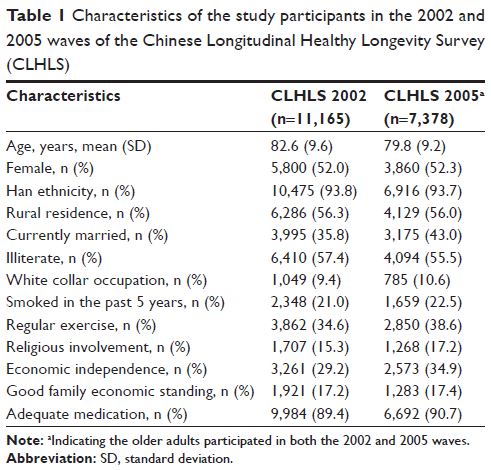108985
论文已发表
注册即可获取德孚的最新动态
IF 收录期刊
- 3.4 Breast Cancer (Dove Med Press)
- 3.2 Clin Epidemiol
- 2.6 Cancer Manag Res
- 2.9 Infect Drug Resist
- 3.7 Clin Interv Aging
- 5.1 Drug Des Dev Ther
- 3.1 Int J Chronic Obstr
- 6.6 Int J Nanomed
- 2.6 Int J Women's Health
- 2.9 Neuropsych Dis Treat
- 2.8 OncoTargets Ther
- 2.0 Patient Prefer Adher
- 2.2 Ther Clin Risk Manag
- 2.5 J Pain Res
- 3.0 Diabet Metab Synd Ob
- 3.2 Psychol Res Behav Ma
- 3.4 Nat Sci Sleep
- 1.8 Pharmgenomics Pers Med
- 2.0 Risk Manag Healthc Policy
- 4.1 J Inflamm Res
- 2.0 Int J Gen Med
- 3.4 J Hepatocell Carcinoma
- 3.0 J Asthma Allergy
- 2.2 Clin Cosmet Investig Dermatol
- 2.4 J Multidiscip Healthc

中国老年人的虚弱转变和死亡类型:一项以人群为基础的队列研究
Authors Liu ZY, Wei YZ, Wei LQ, Jiang XY, Wang XF, Shi Y, Hai H
Received 15 November 2017
Accepted for publication 16 March 2018
Published 16 May 2018 Volume 2018:13 Pages 947—956
DOI https://doi.org/10.2147/CIA.S157089
Checked for plagiarism Yes
Review by Single-blind
Peer reviewers approved by Dr Colin Mak
Peer reviewer comments 2
Editor who approved publication: Dr Richard Walker
Background: Little
is known about the adverse effects of frailty transitions. In this study, we
aimed to characterize the transitions between frailty states and examine their
associations with the type of death among older adults in China, a developing
country with a rapidly growing aging population.
Methods: We used data of 11,165 older adults (aged 65–99 years) from the
2002 and 2005 waves of the Chinese Longitudinal Healthy Longevity Survey
(CLHLS). Overall, 44 health deficits were used to construct frailty index (FI;
range: 0–1), which was then categorized into a three-level variable: nonfrail
(FI ≤0.10), prefrail (0.10< FI ≤0.21), and frail (FI >0.21). Outcome was
four types of death based on bedridden days and suffering state (assessed in
the 2008 wave of CLHLS).
Results: During the 3-year period, 3,394 (30.4%) participants had transitioned
between different frailty states (nonfrail, prefrail, and frail), one-third
transitioned to death, and one-third remained in previous frailty states.
Transitions to greater frailty (ie, “worsening”) were more common than
transitions to lesser frailty (ie, “improvement”). Among four categories of
frailty transitions, “worsening” and “remaining frail” had increased risks of
painful death, eg, with odds ratios of 1.92 (95% confidence interval [CI]
=1.41, 2.62) and 4.75 (95% CI =3.32, 6.80), respectively, for type 4 death (ie,
≥30 bedridden days with suffering before death).
Conclusion: This large sample of older adults in China supports that frailty
is a dynamic process, characterized by frequent types of transitions.
Furthermore, those who remained frail had the highest likelihood of
experiencing painful death, which raises concerns about the quality of life in
frail populations.
Keywords: frailty, transition, older adult, death
